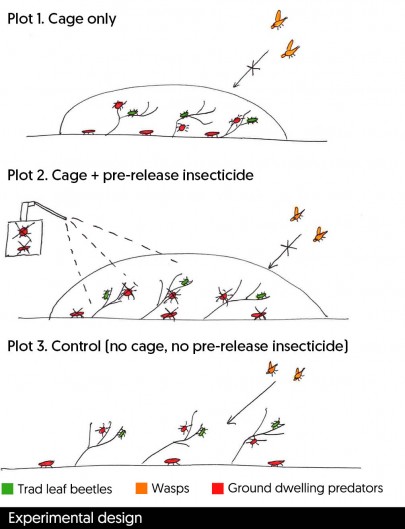Predation and the Tradescantia Leaf Beetle
 To determine if predation is an important factor in the success of the tradescantia leaf beetle, we set up an experiment in the Manawatū–Whanganui region. For the experiment, nine sites in a range of different habitats were selected, some of which had willow trees with giant willow aphids (Tuberolachnus salignus), which are known to support large wasp densities. At each site, three plots (0.25 m2) with tradescantia (Tradescantia fluminensis) infestations were set up approximately 100 m apart. Two of the three plots had different treatments applied: (i) a protective cage covering the plots to exclude flying predators such as wasps; and (ii) a protective cage covering the plots and a pre-release insecticide treatment (non-residual Kiwicare Organic Insect Control with pyrethrum) to kill any ground-dwelling predators. The third plot at each site was a control, where no treatments were applied (i.e no cage and no insecticide).
To determine if predation is an important factor in the success of the tradescantia leaf beetle, we set up an experiment in the Manawatū–Whanganui region. For the experiment, nine sites in a range of different habitats were selected, some of which had willow trees with giant willow aphids (Tuberolachnus salignus), which are known to support large wasp densities. At each site, three plots (0.25 m2) with tradescantia (Tradescantia fluminensis) infestations were set up approximately 100 m apart. Two of the three plots had different treatments applied: (i) a protective cage covering the plots to exclude flying predators such as wasps; and (ii) a protective cage covering the plots and a pre-release insecticide treatment (non-residual Kiwicare Organic Insect Control with pyrethrum) to kill any ground-dwelling predators. The third plot at each site was a control, where no treatments were applied (i.e no cage and no insecticide).
Approximately 8 weeks after the insecticide treatments were applied, in January 2020, 100 tradescantia leaf beetles were added to each of the three plots at all nine sites. The sites were visited several times until the summer of 2022 to make observations, look for signs of ground-dwelling predator activity, and record any leaf beetle damage or sightings. Wasp traps were also deployed during the summer of 2021, and a 5-minute wasp count was made during May 2021.
Of the nine beetle releases that were made in the control plots, only four established (44%), whereas 14 out of 18 releases (78%) in the plots that had cages established – seven from each treatment. Nine months after the releases took place, feeding damage in some of the caged plots was so severe that the cages needed to be lifted to allow some beetles to escape. Evidence of beetle persistence and population growth from a few of these plots was difficult to find, or was not found again, probably because the cages were not removed soon enough and the beetles starved. Of the four successful releases in the control plots, the plants had very little damage during the first 9-month period.
Common wasps (Vespula vulgaris) were recorded at eight of the nine experimental sites, and were found in close proximity to 15 of the 27 plots where the leaf beetles were released. Of the four successful control releases, three established in the presence of wasps and one of the five failures occurred in a wasp-free area. Caged beetle populations persisted at several sites following cage removal, despite very high wasp densities (over 30 wasps in a 5-minute count). One of these sites was less than 10 m away from the entrance of a very large wasp nest. Ground dwelling predators were also present but did not appear to limit population growth of the beetles.
Although caged releases were more successful than releases in the control plots, the rapid population build-up of beetles in cages could be unrelated to a reduction in predation pressure. The Allee effect, which is characterised by a correlation between population density and fitness of a population, is a possible alternative explanation. Allee effects can range from behavioural to physiological factors and, in the case of low insect densities, may result in a lack of mating opportunities. Given the rapid population growth of leaf beetles when caged, and a lack of direct evidence to suggest predation is limiting population growth when the cages are removed, it is possible that we avoided an Allee effect by initially keeping the leaf beetles in a confined space, thereby improving the chances of population survival. As a result, we recommend tradescantia leaf beetles be caged or confined for one generation after their release to increase the chance they will establish. However, a close eye needs to be kept on the population to ensure the beetles don’t eat all the leaf material inside the cages and die out before being freed.
Key contact

